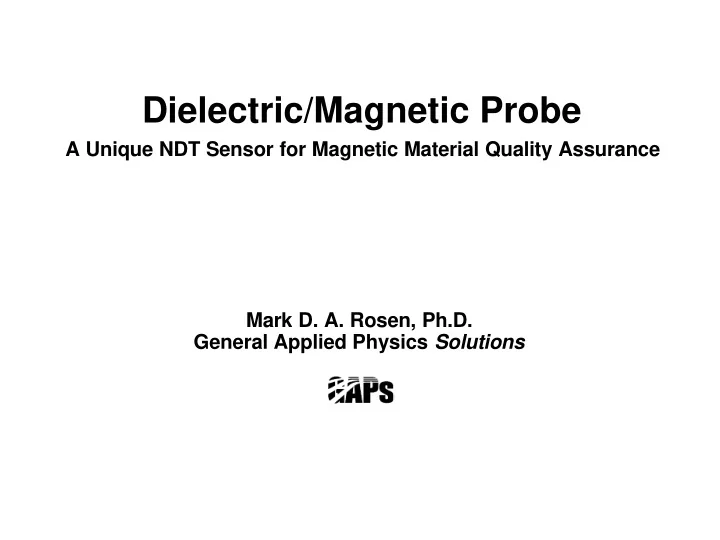

Dielectric/Magnetic Probe A Unique NDT Sensor for Magnetic Material Quality Assurance Mark D. A. Rosen, Ph.D. General Applied Physics Solutions
Approach • Simple, cost effective measurement techniques - Measure parameters directly related to performance • Ability to measure local variations (spatial mapping) • Adaptable to automation (if needed)
NDT for Measuring Electromagnetic Properties • Eddy Current and Interdigital Patterned Sensors Can be sensitive to dielectric and magnetic properties but limited to frequencies less than HF (<30 MHz) • Open-Ended Transmission Line Determine ε by the interaction of a material with the fringing field at the end of an open transmission line • Free-space (NRL Arch; Radar Range*) Measure the reflection and/or transmission of a plane wave in free space using a flat panel (NRL arch or range), fabricated component (range) or final assembled part *including non-anechoic impulse imaging radar
Open-Ended Coaxial Dielectric Probe Material ( ε , µ) • Both the electric and magnetic field components interact with the sample and affect the magnitude and phase of the reflected wave • Altering the magnetic character (µ) in a controlled way can change the reflected wave’s amplitude and phase
Effect of Applied Magnetic Field on Permeability Y 3 Al 0.66 Fe 4.34 O 12 From: G. G. Bush, J. Appl. Phys. 64 (1988), 5653
Effect of Applied Magnetic Field on Probe Response HP Probe Feasibility Test of Concept Plessey Material Plessey 1634 MagRAM Ground Plane (Al) 36 mils Magnet 24 6 22 With field 5 20 With field 4 18 16 3 Response Response 14 2 Probe Probe 12 1 ') ε 10 ( ") ε ( 8 0 0 4 8 12 16 20 0 4 8 12 16 20 Frequency (GHz) Frequency (GHz)
Dielectric/Magnetic Probe Modified Open-Ended Coaxial Probe • Addition of an axial coil for applying an external magnetic field • External field can alter the contribution of the material’s magnetic spins (dipoles) • Difference in the probe response with and without the field is related to µ of the material • Patented
Dielectric/Magnetic Probe Design Beryllium Copper Outer Conductor Soft Magnetic Sleeve Magnetic Field Coil Non-magnetic Metal Teflon Spacer Pure Iron Center Conductor
Prototype Probes
Measurement Problem Lack of reproducible measurement due to contact variations with the sample: - operator dependent - sample surface dependent (not flat and/or rough)
Conformal Tip • Use of custom designed spring loaded test pins • Pins adjust to surface imperfections (roughness and/or curvature) • Pins allow wave to propagate to surface so that fringing field interacts with sample (eliminates air gap effect) • Patented First Prototype (7mm Probe)
Dielectric/Magnetic Probe Modeling Tools High Frequency Structure Simulator (HFSS) High Frequency Structure Simulator (HFSS) Source: Hewlett-Packard Company Computes S-parameters for passive 3D structures by finite element solution of Maxwell’s equations Powerful tool for modeling the response of our probe (S11, reflected wave amplitude and phase) Magneto Magneto Source: Integrated Engineering Software, Inc. Software for solving magnetostatic problems using boundary element method Used to optimize magnetic field coupling to sample volume sensed by probe
Comparison Between Measurement and Modeling HFSS Calculations GrumProbe™ Measurements 0 0 m ) Mag(w/field)-Mag(w/o field) -0.01 -0.05 Mag(µ=1)-Mag(µ=µ -0.02 -0.1 -0.03 -0.15 Freq= 2.0 GHz -0.04 -0.2 Material: FeAl composite Freq = 2.0 GHz -0.05 -0.25 1 1.5 2 2.5 3 3.5 4 1 1.5 2 2.5 3 3.5 4 µ' µ' Difference indicates that the applied magnetic field was not able to completely turn off the magnetic permeability (µ)
Probe Frequency Response (Signature) 0.1 0.5 ASD QC Sample 0 CL4 56mils 0 Magnitude Difference Phase Difference -0.1 -0.5 -0.2 -1 -0.3 -1.5 -0.4 -2 -0.5 -2.5 -0.6 -0.7 -3 0 2 4 6 8 10 Frequency (GHz) Signature is influenced by: (1) ε & µ (2) Structure (3) Physical defects
Effect of Thickness on 7mm Probe Response Probe is sensitive to the thickness as well as to the electromagnetic properties 2.4 Position of Freq Peak (GHz) PR2407-CL4 2.2 2 1.8 1.6 1.4 1.2 10 20 30 40 50 60 Thickness (mils)
Dielectric/Magnetic Probe A New Unique NDT Sensor for Magnetic Material Quality Assurance • Sensor is sensitive to both ε & µ • Very Broadband • Easily Addresses the very difficult to measure frequency range below 4 GHz • Can provide – Spatial Mapping – Depth Profile of Structures • Provides Processing Control
Recommend
More recommend